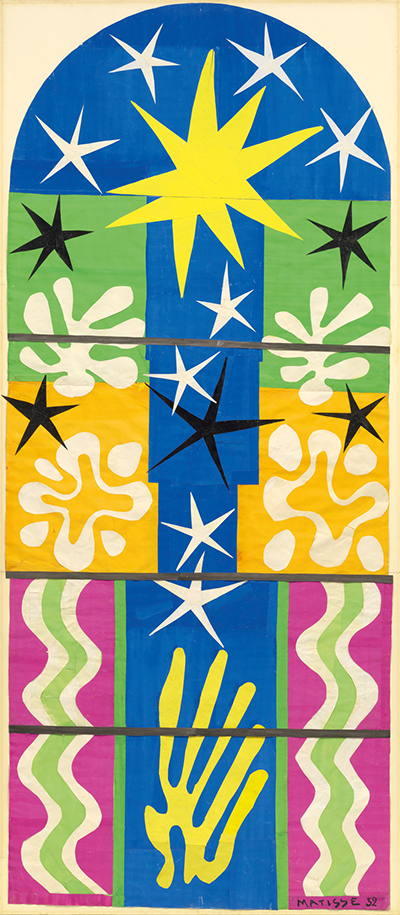Nuit de Noel is an inspiring design which combines two very different art mediums, namely Matisse's cut out techniques and also the traditional methods of stained glass windows. He attempts to, yet again, re-invent and modernise old ways and breathe new life into the art world.
Matisse was entirely innovative but also adaptable. His signature style could be stretched across into a number of different mediums and he loved the challenge of doing so. Pale Blue Window offers another example of how he planned out the artworks to fit windows using his minimalist approach. As his reputation grew, Matisse would attract many more patrons who put their confidence into his abilities, even though they knew he was bringing a much more contemporary approach than perhaps they were normally used to. Stained glass window design is an artistic genre that was particularly common within France and the UK but slowly died out once the availability of patrons dried up. The art form was fragile and religious institutions became less able to commission artworks for their many buildings. Matisse clearly saw something in the art form and wanted to append his own ideas upon it.
A bright yellow star initially captures your attention. It sits at the top of this composition, similar to how a bright sun might look down upon us. It is surrounded by white stars which are smaller and surround its top half. There are then panels of bright colour that form the rest of the composition, including green, orange and purple, with a strip of blue that makes its way right down the centre of the work. Within those panels are several natural shapes such as leaves which also re-appear within a number of Matisse's other artworks. The artist is known to have created stars from individual triangles of paper which would then be arranged together, rather than attempting to produce the piece in one whole shape.
The artist would leave behind a substantial oeuvre which ran into the many hundreds of artworks, taking in a huge variety of artistic disciplines. He would have to adapt over time as his health deteriorated but his creativity would never diminish. Figurative art and depictions of items from nature featured regularly. He also loved to capture shoulder length portraits, though those were normally completed just in oils see portrait of madame matisse. the green line for a particularly famous example of that. The interest in this artist has ensured that even his study sketches and preparatory pieces now command considerable value and would be of interest to a large number of collectors. The hard working nature of this passionate artist ensures that new items from his career appear in the public domain fairly regularly, although not all receive accreditation as forgeries can also surface from time to time.




